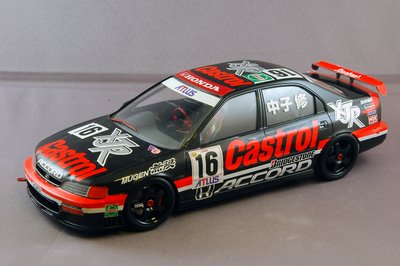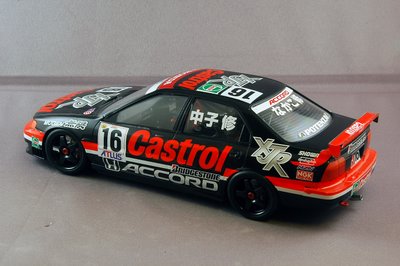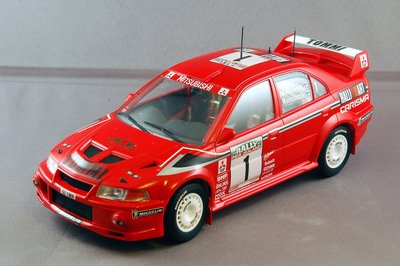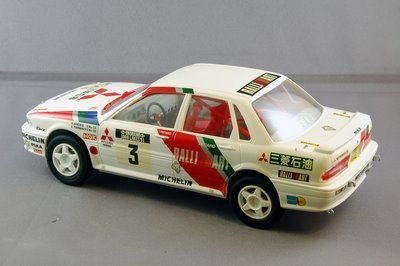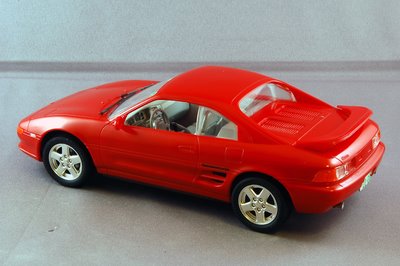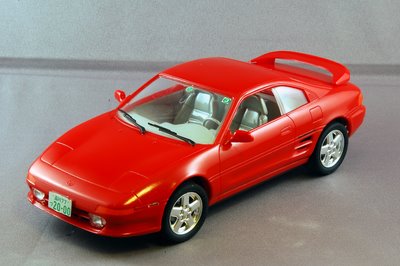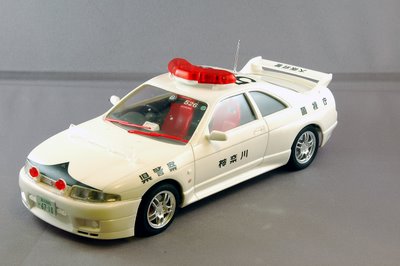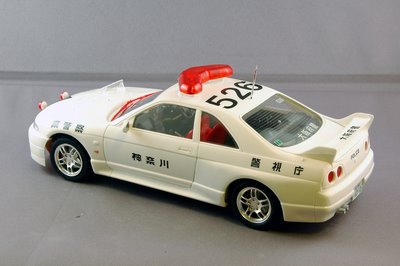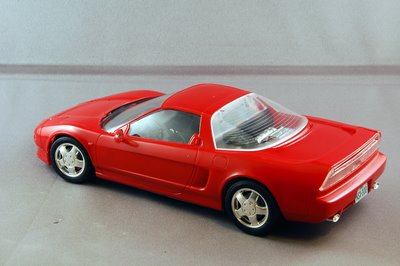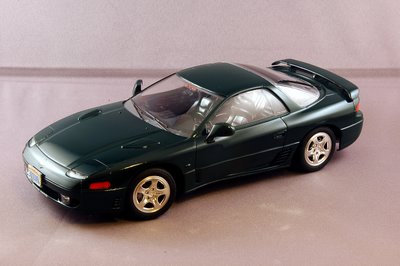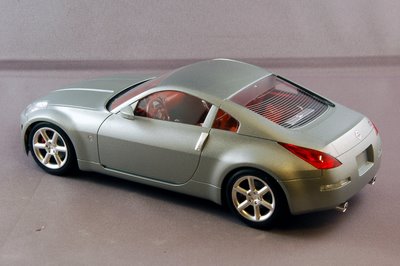LS Plastic Model Japanese Car Collection
Models were personally build but commentaries are gleaned from information available in the web.
Tuesday, September 05, 2006
Lancer Evolution VI WRC Model Car by Tamiya 1/24 Scale
The Evo VI's changes mainly focused on cooling and engine durability. It received a larger intercooler, larger oil cooler, and new pistons, along with a titanium-aluminide turbine wheel for the RS model, which was a first in a production car. Also, the Evo VI received new bodywork yet again, with the most easily spotted change in the front bumper where the huge foglights were reduced in size and moved to the corners for better airflow. A new model was added to the GSR and RS lineup; known as the RS2, it was an RS with a few of the GSR's options. Another limited-edition RS was known as the RS Sprint, and was tuned by Ralliart to be lighter and more powerful with 330 hp.
Yet another special edition Evo VI was also released in 1999: the Tommi Makinen edition, named after Finnish rally driver Tommi Makinen that had won Mitsubishi four WRC drivers championships. It featured Red/Black Recaro seats (with embossed T. Makinen logo), 17" ENKEI white wheels, a leather MOMO steering wheel and shift knob, a titanium turbine that spooled up quicker, front upper strut brace, lowered with tarmac stages in mind, a quicker lock to lock and amongst others colours, came in an exclusive shade of red with special decals, replicating Tommi Makinen's rally car's colour scheme. This car is also sometimes referred to as an Evo 6½.
It was during the Evo VI's model run that American car enthusiasts, who had been previously denied the Evolution models, began to clamour for its introduction to the United States. [citation needed] This was primarily due to exposure of the Evolution in video games such as the Gran Turismo series. [citation needed]
Hasegawa Mitsubishi Galant VR-4 Rally 1991 1000 Lakes Rally 1/24 Scale
The Mitsubishi Galant VR-4 was the range-topping version of Mitsubishi Motors' Galant model, available in the sixth (1988–92), seventh (1992–96) and eighth (1996–2002) generations of the vehicle. Originally introduced to comply with the new Group A regulations of the World Rally Championship, it was soon superseded as Mitsubishi's competition vehicle by the Lancer Evolution, and subsequently developed into a high-performance showcase of the company's technology.
Full History:
http://www.answers.com/topic/mitsubishi-galant-vr-4
Fujimi Toyota MR2 GT 1993 Model 1/24 Scale
The MR2 went through a complete redesign in 1989, when the new Mk II body was produced. The new MR2, designated SW20 (in America the chassis codes were SW22 for the turbocharged model and SW21 for the naturally-aspirated model), was longer, wider and heavier than its predecessor and had smoother bodylines.
While the AW11 was a pure sports car, made in the spirit of Lotuses, the SW20, being quite larger, could be classed as a GT-car. Since the resemblance between the Ferrari 348tb and the Ferrari F355 and the new MR2 was quite striking, the SW20 is sometimes referred to as a "poor man's Ferrari". Indeed, many bodykits became available to make the SW20 imitate the Ferrari F355 with, sometimes, indistinguisable effects.
Fujimi Nissan R33GT-R 1/24 Scale
A heavy burden lay upon the R33's back when it was introduced in 1995. The previous R32 GT-R had been extremely successful (almost unbeatable) and nobody thought the new GT-R could possibly improve on the R32’s performance. Surprisingly, the R33 GT-R was better than the old version in almost every way, although it too had put on some weight.
The R33 GTR kept the RB26DETT engine with an unchanged 280hp, but had a broader torque band which made the engine more flexible. The engine's maximum torque output had been increased by 1.5kg-m to 37.5kg-m at 4400rpm as a result of revising the computer control parameters and improving the intercooler. Also standard were improved versions of ATTESA-ETS and Super-HICAS. Four-wheel Multi-Link suspension had been further improved for enhanced performance.
Tamiya Honda NSX 1/24 Scale
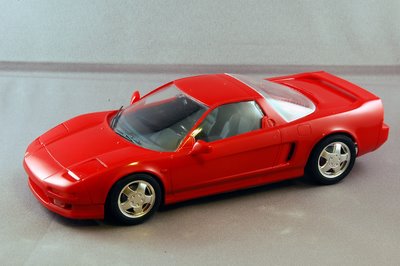 1990 Honda NSX , # 24100, Tamiya 1/24 kit features detailed DOHC V6 & 5 speed trans, complete detailed chassis, front/rear suspension, brake details, RHD/LHD dashs options, wipers and steering wheels, can be built as either a Honda or Accura NSX, satin chrome plated 5 spoke factory mags & Advan tyres.
1990 Honda NSX , # 24100, Tamiya 1/24 kit features detailed DOHC V6 & 5 speed trans, complete detailed chassis, front/rear suspension, brake details, RHD/LHD dashs options, wipers and steering wheels, can be built as either a Honda or Accura NSX, satin chrome plated 5 spoke factory mags & Advan tyres.NSX comes with a lift-off "targa" roof panel, a 290-hp 3.2-liter V6, and a 6-speed manual transmission. A 4-speed automatic transmission with manual-shift feature is available by special order and teams with a 252-hp 3.0-liter V6. Standard are ABS, traction control, and 17-inch wheels, plus leather upholstery, keyless entry system, and trunk-mounted CD changer. Side airbags are unavailable.
Tamiya Mitsubishi 3000GT VR-4 1/24 Scale
 The development concept behind Mitsubishi's GTO Twin Turbo was to create a fun-to-drive, but safe, 4WD sports car that could raise the performance ability of the average driver.
The development concept behind Mitsubishi's GTO Twin Turbo was to create a fun-to-drive, but safe, 4WD sports car that could raise the performance ability of the average driver.Under the muscular body styling lies a transverse mounted, 3 liter, DOHC V-6 cylinder, twin-turbocharged and intercooled powerplant. This mulipoint fuel-injected engine produces 280 horsepower at 6000rpm and 42.5kg-m of torque at a remarkably low 2500rpm.
Power from this awesome engine is channeled through a 5-speed manual German made, Getrag transmission. The full-time 4WD system incorporates a center planetary differential with viscous coupling.
From this unit, a sleeve shaft supplies power to the front differential, while a concentric solid shaft delivers power to the rear, limited slip differential. The front and rear 45:55 torque split ration is automatically controlled according to running and track conditions. Front MacPherson struts and rear double wishbone suspension guarantees sure-footed performance under harsh weather conditions.
In addition, the widely spaced wheels are fitted with fat tires to provide a stable and firm ride. Ventilated disk brakes at all corners are assisted by an anti-lock braking system, providing positive stopping performance.
Nissan 350Z
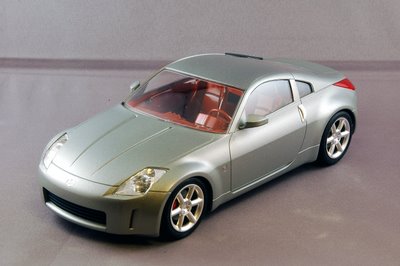 Retaining the nostalgic lines of the original Z that was released 30 years earlier, the Nissan 350Z, with its sharply cut front and rear fenders, has become the number one Japanese sports car.
Retaining the nostalgic lines of the original Z that was released 30 years earlier, the Nissan 350Z, with its sharply cut front and rear fenders, has become the number one Japanese sports car.The 350Z is equipped with a 3.5 liter V6 Engine producing 280hp and a 6-speed manual or 5-speed electronically controlled automatic transmission.
The Nissan 350Z's aluminum arms employ 4-wheel independent multi-link suspension and feature ripple controlled shock absorbers that effectively absorb road unevenness to make this sports car both quick and easy to drive.
The Track version is the most sportive and luxurious model of the Nissan 350Z. Wheels and characteristic door handles reproduced as chrome plated parts. Orange transparent parts for turn signals and red transparent parts for taillights are included in kit.
Both left and right steering columns (2 dashboards) will be included so modelers can have the option of assembling the export, or domestic Japanese version. In pursuit of the utmost realism emblem and aluminum on doors are reproduced with metal transfer marks.
